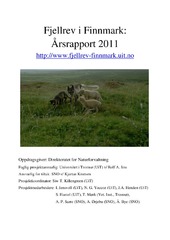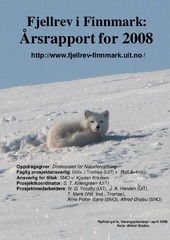Blar i forfatter "Ims, Rolf Anker"
-
Congruent responses to weather variability in high arctic herbivores
Stien, Audun; Ims, Rolf Anker; Albon, Steve D.; Fuglei, Eva; Irvine, R.J.; Ropstad, Erik; Halvorsen, Odd; Langvatn, Rolf; Loe, Leif Egil; Veiberg, Vebjørn; Yoccoz, Nigel (Journal article; Tidsskriftartikkel; Peer reviewed, 2012-09-26)Assessing the role of weather in the dynamics of wildlife populations is a pressing task in the face of rapid environmental change. Rodents and ruminants are abundant herbivore species in most Arctic ecosystems, many of which are experiencing particularly rapid climate change. Their different life-history characteristics, with the exception of their trophic position, suggest that they should show ... -
Contrasting changes in space use induced by climate change in two Arctic marine mammal species
Hamilton, Charmain Danielle; Vacquie-Garcia, Jade; Kovacs, Kit M.; Ims, Rolf Anker; Kohler, Jack; Lydersen, Christian (Journal article; Tidsskriftartikkel; Peer reviewed, 2019-03-06)Global warming is inducing major environmental changes in the Arctic. These changes will differentially affect species owing to differences in climate sensitivity and behavioural plasticity. Arctic endemic marine mammals are expected to be impacted significantly by ongoing changes in their key habitats owing to their long life cycles and dependence on ice. Herein, unique biotelemetry datasets for ... -
Declining willow ptarmigan populations : the role of habitat structure and community dynamics
Henden, John-André; Ims, Rolf Anker; Yoccoz, Nigel; Killengreen, Siw Turid (Journal article; Tidsskriftartikkel; Peer reviewed, 2011)The recent range contractions and population declines of many grouse species worldwide have been attributed to loss and fragmentation of their habitats, although the empirical evidence for the actual drivers is often weak. In case of the willow ptarmigan Lagopus lagopus in Fennoscandia, ungulate overbrowsing of willows has been hypothesized to exert such negative habitat-related impacts. Moreover, ... -
Dietary variation in Icelandic arctic fox (Vulpes lagopus) over a period of 30 years assessed through stable isotopes
Carbonell Ellgutter, Jennifer Alejandrina; Ehrich, Dorothee; Killengreen, Siw Turid; Ims, Rolf Anker; Unnsteinsdóttir, Ester Rut (Journal article; Tidsskriftartikkel, 2019-12-21)Identifying resources driving long-term trends in predators is important to understand ecosystem changes and to manage populations in the context of conservation or control. The arctic fox population in Iceland has increased steadily over a period of 30 years, an increase that has been attributed to an overall increase in food abundance. We hypothesized that increasing populations of geese or seabirds ... -
Direct and indirect effects of environmental drivers on reindeer reproduction
Henden, John-André; Tveraa, T.; Stien, Audun; Mellard, Jarad; Marolla, Filippo; Ims, Rolf Anker; Yoccoz, Nigel (Journal article; Tidsskriftartikkel; Peer reviewed, 2021-05-27)The impact of climate change on the dynamics of populations has been well documented and is widespread. However, weather variability influences populations both directly and indirectly, and is mediated by species interactions. This complexity may impede proper climate impact assessments. Hence, predicting the consequences of climate change may require including processes that occur both with time ... -
Disturbance mapping in arctic tundra improved by a planning workflow for drone studies: Advancing tools for future ecosystem monitoring
Eischeid, Isabell; Soininen, Eeva M; Assmann, Jakob J.; Ims, Rolf Anker; Madsen, Jesper; Pedersen, Åshild Ø.; Pirotti, Francesco; Yoccoz, Nigel; Ravolainen, Virve T. (Journal article; Tidsskriftartikkel; Peer reviewed, 2021-11-06)The Arctic is under great pressure due to climate change. Drones are increasingly used as a tool in ecology and may be especially valuable in rapidly changing and remote landscapes, as can be found in the Arctic. For effective applications of drones, decisions of both ecological and technical character are needed. Here, we provide our method planning workflow for generating ground-cover maps with ... -
Drones and marine mammals in Svalbard, Norway
Palomino-González, Albert; Kovacs, Kit M.; Lydersen, Christian; Ims, Rolf Anker; Lowther, Andrew D. (Journal article; Tidsskriftartikkel; Peer reviewed, 2021-03-14)The impact of remotely piloted aircraft systems (RPAS) on marine mammals remains poorly documented despite their increasing use. In the high-Arctic Archipelago of Svalbard, where marine mammals face increasing pressure from climate change and expanding tourism, the use of RPAS remains largely unregulated. In this study we assessed the impacts of RPAS across a range of species to provide ... -
A Dynamic Occupancy Model for Interacting Species with Two Spatial Scales
Kleiven, Eivind Flittie; Barraquand, Frédéric; Gimenez, Olivier; Henden, John-André; Ims, Rolf Anker; Soininen, Eeva M; Yoccoz, Nigel (Journal article; Tidsskriftartikkel; Peer reviewed, 2023-04-10)Occupancy models have been extended to account for either multiple spatial scales or species interactions in a dynamic setting. However, as interacting species (e.g., predators and prey) often operate at different spatial scales, including nested spatial structure might be especially relevant to models of interacting species. Here we bridge these two model frameworks by developing a multi-scale, ... -
Ecosystem drivers of an Arctic fox population at the western fringe of the Eurasian Arctic
Ims, Rolf Anker; Killengreen, Siw Turid; Ehrich, Dorothee; Flagstad, Øystein; Hamel, Sandra; Henden, John-André; Jensvoll, Ingrid; Yoccoz, Nigel Gilles (Journal article; Tidsskriftartikkel; Peer reviewed, 2017-08-16)The distribution of traditional breeding dens on the Varanger Peninsula (70–71°N) in northernmost Fennoscandia indicates that this area once harboured a large Arctic fox population. Early 20th century naturalists regarded the coastal tundra of the Fennoscandian Low Arctic to be a stronghold for the species. At the start of our research in 2004, however, the local Arctic fox population was ... -
Effect of scavenging on predation in a food web
Mellard, Jarad; Hamel, Sandra; Henden, John-André; Ims, Rolf Anker; Stien, Audun; Yoccoz, Nigel (Journal article; Tidsskriftartikkel; Peer reviewed, 2021-04-26)<ol> <li>The fasting endurance hypothesis (FEH) predicts strong selection for large body size in mammals living in environments where food supply is interrupted over prolonged periods of time. The Arctic is a highly seasonal and food-restricted environment, but contrary to predictions from the FEH, empirical evidence shows that Arctic mammals are often smaller than their temperate conspecifics. ... -
Effects of changing permafrost and snow conditions on tundra wildlife: critical places and times
Berteaux, Dominique; Gauthier, Gilles; Dominé, Florent; Ims, Rolf Anker; Lamoureux, Scott F; Lévesque, Esther; Yoccoz, Nigel Gilles (Journal article; Tidsskriftartikkel; Peer reviewed, 2016-12-21)The change of water phase around 0 °C has considerable impacts on wildlife ecology because liquid and solid water strongly differ in their insulating capability, mechanical resistance, and light reflectance. Freeze and melt events thus have strong ecological relevance, particularly in the Arctic where snow and ice are omnipresent and their conditions are changing due to climate warming. We first ... -
Emergent rainy winter warm spells may promote boreal predator expansion into the arctic
Sokolov, Aleksandr A.; Sokolova, Natalya A.; Ims, Rolf Anker; Brucker, Ludovic; Ehrich, Dorothee (Journal article; Tidsskriftartikkel; Peer reviewed, 2016-06-06)Climate change has been characterized as the most serious threat to Arctic biodiversity. In addition to gradual changes such as climate warming, extreme weather events, such as melting temperatures in winter and rain on snow, can have profound consequences for ecosystems. Rain-on-snow events lead to the formation of ice layers in the snow pack, which can restrict access to forage plants and cause ... -
End-user involvement to improve predictions and management of populations with complex dynamics and multiple drivers
Henden, John-André; Ims, Rolf Anker; Yoccoz, Nigel; Asbjørnsen, Einar Johannes; Stien, Audun; Mellard, Jarad Pope; Tveraa, Torkild; Marolla, Filippo; Jepsen, Jane Uhd (Journal article; Tidsskriftartikkel; Peer reviewed, 2020-03-11)Sustainable management of wildlife populations can be aided by building models that both identify current drivers of natural dynamics and provide near-term predictions of future states. We employed a Strategic Foresight Protocol (SFP) involving stakeholders to decide the purpose and structure of a dynamic state-space model for the population dynamics of the Willow Ptarmigan, a popular game species ... -
Environmental conditions alter successional trajectories on an ephemeral resource: a field experiment with beetles in dead wood
Vindstad, Ole Petter Laksforsmo; Birkemoe, Tone; Ims, Rolf Anker; Sverdrup-Thygeson, Anne (Journal article; Tidsskriftartikkel; Peer reviewed, 2020-10-07)Successional processes can be observed for many organisms and resources, but most studies of succession have focused on plants. A general framework has been proposed, advocating that successional patterns in species turnover are predominantly driven by competition, dispersal or abiotic limitation, and that the patterning of species accumulation over time gives clues to which process is most influential ... -
Fjellrev i Finnmark : årsrapport 2011
Killengreen, Siw Turid; Jensvoll, Ingrid; Henden, John-André; Hamel, Sandra; Ims, Rolf Anker; Mørk, Torill; Sarre, Arne Petter; Ørjebu, Alfred; Bye, Åshild; Knutsen, Kjartan (Research report; Forskningsrapport, 2012) -
Fjellrev i Finnmark : Årsrapport 2013
Ims, Rolf Anker; Killengreen, Siw Turid; Jensvoll, Ingrid; Yoccoz, Nigel Gilles; Henden, John-André; Arriola, Aline; Mørk, Torill; Sarre, Arne Petter; Ørjebu, Alfred; Kristoffersen, Bjørn Hugo; Bye, Åshild (Research report; Forskningsrapport, 2013)Prosjekt Fjellrev i Finnmark har pågått siden 2004. Prosjektet har fra starten av hatt to målsetninger: Å gjøre grunnleggende forskning på økosystembetingelser som begrenser fjellrevenbestandens nåværende utbredelse og bestandsvekst i Øst-Finnmark spesielt, og i sub- og lav-Arktis generelt, med fokus på to hypoteser; a) mer uregelmessige og dempede smågnagersykler og b) øket konkurranse med ... -
Fjellrev i Finnmark : årsrapport for 2008
Ims, Rolf Anker; Knutsen, Kjartan; Mørk, T.; Killengreen, Siw Turid; Yoccoz, Nigel Gilles; Sarre, Arne Petter; Ørjebu, Alfred; Henden, John-André (Research report; Forskningsrapport, 2008) -
Fjellrev i Finnmark : forskning og tiltak 2004
Langeland, K.; Ims, Rolf Anker; Killengreen, Siw Turid; Skog, E.; Scheie, J.O.; Yoccoz, Nigel Gilles; Bråthen, Kari Anne (Research report; Forskningsrapport, 2004) -
Fjellrev i Finnmark : forskning og tiltak 2005
Skog, E.; Ims, Rolf Anker; Killengreen, Siw Turid; Scheie, J. O.; Mørk, T.; Yoccoz, Nigel Gilles; Henden, John-André; Langeland, K.; Ravolainen, Virve (Research report; Forskningsrapport, 2005) -
Fjellrev i Finnmark : forskning og tiltak 2006
Knutsen, Kjartan; Ims, Rolf Anker; Mørk, T.; Killengreen, Siw Turid; Langeland, K.; Yoccoz, Nigel Gilles; Henden, John-André; Ravolainen, Virve (Research report; Forskningsrapport, 2006)


 English
English norsk
norsk


















